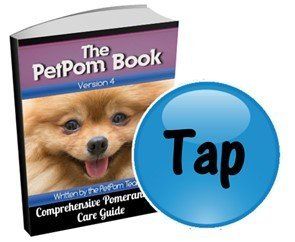Seniors
PetPom
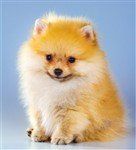
The
Pomeranian
Information
Center
Senior Pomeranian Care
Overview
As we have learned in 'Age', a Pomeranian grows up very quickly. There is no exact
official age of becoming a senior. Small toy breed dogs such as the Pom can be considered to be a "Senior" as early as 7 and usually no later than 9.
In general, it is safe to say that the senior years begin at 8 years old.
We are going to go over some of the changes that will happen as your Pom grows older.
So, even if you have a puppy right now, remember that time moves by very quickly and we must be aware of the needs that older Pomeranians have.
With an average life span of 12 to 16, Poms often live well into their teens, as active and happy as ever, with proper care.
With diligent at-home care, a great veterinarian and also some luck, a Pom can even reach his 20's, as did the oldest known Pomeranian
(however, if a Pom passes at 12 or older, this is considered 'normal').
Geriatric Screenings
When your Pom is 7-9 years old, additional testing should be performed during twice-a-year checkups that look for issues that are more common with older dogs.
In general, a geriatric screening of your dog will include: (1)
a thorough, hands-on physical exam; (2)
blood tests; (3)
possibly an electrocardiogram; (4)
specialized tests depending on your dog's health
history. Some vets advise semi-annual visits once your dog becomes a senior. An annual visit is an absolute minimum. In between visits to the vet and annual geriatric screenings, you can stay alert to behavioral
changes and other signs of aging.
Red Flags Regarding Health Issues with Older Poms
• Sudden weight loss
is an early warning sign of many health issues ranging from infection to diabetes. When a Pom loses weight, even a pound or so, this is most often noticeable around the rib cage and often owners will either feel this when picking up their dog or see a change when the coat is wet during bath time.
• Serious loss of appetite
- As a dog ages, the metabolism slows down a bit and it is normal for older dogs to eat a bit less. However the first sign of many illness that strike older dogs is a lack of appetite. If you notice that your Pom is eating little and is losing weight, this is your sign to make an appointment right way.
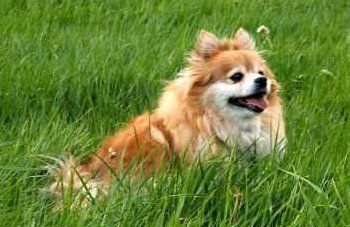
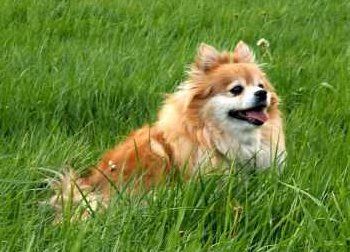
• Intestinal distress
- Diarrhea
or vomiting, can be serious for toy breeds; and particularly with very young puppies and older, senior Poms that are more vulnerable to accompanying dehydration that often occurs.
• Increased thirst, without a change in activity level, and increased urination are other signs of diabetes. Your dog should be tested as soon as possible.
• Lethargy
- Tiring more quickly than when younger is normal as a dog ages, however it may also be a sign of disease affecting the heart or lungs. If this becomes troubling bring your dog to the vet who can rule out any cardio-pulmonary problems.
You may need to modify activity routines to avoid overtaxing an older dog. Seniors may need a slower pace; for example 2 smaller walks per day instead of one longer walk.
• Coughing and excessive panting
may indicate heart disease. If these symptoms persist even after you've modified your dog's exercise program, visit the vet.
Expected Issues with Seniors
•
Problems with vision and hearing are natural as a dog ages. Accommodate these changes as best you can -- by not changing the location of furniture, for example, and clapping instead of calling your dog's name if he/she shows signs of decreased hearing.
• Skin and coat changes.
Thinning fur and drying skin are sure signs of aging. More attention to grooming and the introduction of massage will help the condition of the skin and coat. Use high quality products to keep both skin and coat healthy. As always, never brush a dry coat and use a leave-in conditioner.
• Mobility issues -
Difficulty in getting up from a lying position, or other problems with moving may indicate arthritis. Your vet will be able to advise you on ways you can relieve your dog's discomfort and lack of mobility.
• There can be some behavioral changes as a dog grows older.
This includes a lower tolerance for noise and commotion. Certain activities may become a tad overwhelming. The older, senior Pomeranian may have a lower threshold of patience for young children or over-crowded rooms.
Many do best if given a quiet area to retreat to, that is still close enough to observe family activity without being directly involved in all the chaos.
During the early teen years (13+years old), it is not uncommon for some cognitive abilities to decline. This may present as lack of attentiveness, disorientation, roaming in circles, barking at (apparently) nothing and/or becoming withdrawn. While this may be due to the normal aging process, do bring any such changes to the attention of your Pom's veterinarian.
Dental Care for the Senior Pom
Dental care needs to be continuous from the time a dog is young. Without proper care during the puppy, adolescent and adult years, by the time a Pomeranian becomes a senior, the effects of any dental neglect will be evident and potentially shorten the dog's
life span.
Rotting teeth can cause gum and mouth infections, and these infections can migrate to the vital organs and cause serious damage. Gum (periodontal) disease is extremely common in older Pomeranians, and one of the more serious health problems that occurs.
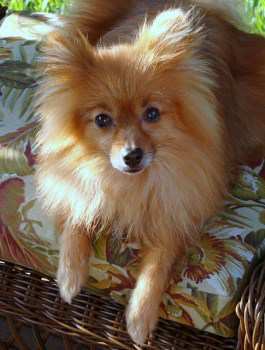

It is never too late to begin a solid at-home dental care routine.
During yearly or twice-a-year visits, both teeth and gums should be checked professionally. Be sure to offer a daily dental treat, like GREENIES Teenie Dental Dog Treats
 ; this is the #1 veterinary recommended dental treat, and has been granted the Seal of Approval by the Veterinary Oral Health Council for controlling plaque and tartar.
; this is the #1 veterinary recommended dental treat, and has been granted the Seal of Approval by the Veterinary Oral Health Council for controlling plaque and tartar.
And routinely brush your Pom's teeth with a quality canine toothpaste and brush.
Exercise Changes for Older Pomeranians
Exercise is as essential to dogs as it is to humans. It is directly tied to a dog's physical, mental, and emotional health. A sedentary dog is a bored dog, and, in general, a less-than-optimally-healthy dog.
As dogs age, they still need their exercise
to benefit their heart, lungs, circulation, digestive system, and joints, and to help keep metabolism on track. Compared with younger dogs, however, older dogs need to adjust the type and duration of the exercise they do.
We recommend two short walks per day. Ideally, you will want each walk to last 15 minutes or so. However, before you head out, there are some things to take care of first, so that your senior can enjoy being outside, and to help prevent issues.
#1. Older Poms tend to get chilled easy.
If your Pom is showing an intolerance, place a small lined vest on him to help maintain core body temperature and keep the chills at bay.
#2 Senior Pom tend to be sensitive to walking surfaces; so now more than ever, you will want to protect the paws from both hot summer surfaces and freezing winter surfaces. Use a quality paw wax that adds traction, adds a layer of protection, and helps to keep paws from drying out.
#3 A Senior Pom's nose may be even more prone to issues.
A drying or peeling, or even chapping in response to outdoor elements is common. Use a quality nose butter to both protect and heal.
#4 Seniors may be a bit unsteady, or look for some more help with balance when outside.
While it is recommended for Poms of all ages, be sure that your senior has a sturdy, well-fitting harness as opposed to a collar when on leash.
Ways to Help a Senior Pomeranian Be Happy and Healthy
There are many things that you do to help keep your senior Pomeranian more comfortable and happy. Your older Pom will need your help as his/her body ages.
• Regular checkups and communication with your veterinarian
will ensure that you are doing all that you can medically to help your Pom enjoy the senior years. With any diagnosis of a serious condition, we recommend obtaining a 2nd opinion.
• Change your Pom’s diet from dog food to senior dog food, if you have been feeding manufactured dog. Your Pom’s body now needs a different amount of carbs, proteins, nutrients and minerals. Of our top recommended brands, two are available in senior varieties.
This would be Orijen Senior 80-20
 which is formulated for older dogs which is packed with health proteins, and fats for optimal health, is grain-free, and has lots of fruits and botanicals. Wellness Complete Health Small Breed Senior Dog Food
which is formulated for older dogs which is packed with health proteins, and fats for optimal health, is grain-free, and has lots of fruits and botanicals. Wellness Complete Health Small Breed Senior Dog Food
 is a good choice as well; this has smaller kibbles that are easier for seniors to eat, and has added glucosamine and chondroitin for healthy hips and joints, and probiotics.
is a good choice as well; this has smaller kibbles that are easier for seniors to eat, and has added glucosamine and chondroitin for healthy hips and joints, and probiotics.
If you older Pomeranian has trouble eating (often due to tooth loss), try drizzling warm low-salt chicken or beef broth over his food.
• Ease distractions
- Senior Pomeranians can be easily startled by or become fearful of children, loud noises, and general commotion as they age. Conditions such as arthritis can make a dog fearful of getting hurt (or the potential to get hurt) with sudden movements of kids or being stepped on.
You may find that a senior Pom enjoys having his own area to retreat to; this would include an indoor playpen with a door, and a comfortable bed.
• Keep an eye out for any odd symptoms and never pass them off as 'normal' for a senior.
Any health issues or behavioral issues should immediately be brought to the attention of your veterinarian. Treatment for health ailments is often most successful when diagnosed early.
Grooming the Senior Pomeranian
When a Pomeranian ages, there will be changes to both skin and coat. There will be a gradual loss of moisture that can cause skin and fur to become dull and dry. The coat protects the skin and therefore a damaged coat in poor condition can lead to other problems. The skin - in turn - affects the coat; if skin becomes too dry it can affect the hair growth cycle.
Keep a routine
- Keeping up with routine grooming will be more important than ever as a Pom transitions into a senior.
Another reason for a routine grooming sessions has to do with an aging Pom’s need for physical contact and attention. While puppies and young dogs are busy running around and passing time playing independently with toys, an older Pom doesn't have as much energy for such things. A grooming session can be an energizer as well as provide an interesting diversion for a dog.
It is also an opportunity for you and your Pom to experience the kind of closeness and physical contact that is reassuring and satisfying and that contributes to your Pom’s overall sense of well-being - which, in turn, stimulates good health.
Use good products
- Always bathe your older Pom with warm water in a warm room. Cold will dry the skin and might cause chilling. Always use a high quality
shampoo since older skin has a tendency toward allergy and dryness.
Do not use a blow-dryer
with an older Pom, which is too hard on the coat and skin. Instead, use thick, absorbent towels.
Use grooming sessions as a means of checking for tumors, growths, or changes in skin condition.
Run your hands over all parts of your Pom’s body - from stem to stern, along the abdomen, legs, ears, and tail.
Early detection of a malignancy can extend your dog's life by years. The skin, as the largest organ of the body, also can indicate internal health problems that may not be otherwise visible. Watch for dryness or roughness of the skin texture, and for any unusual symptoms.
Sleep for the Senior Pom
A senior Pom should have
an orthopedic bed to help with a good night’s sleep and allow comfort to possible aching joints and muscles. Many dogs will insist on lying in doorways and hallways to keep tabs on you, unless you provide them with better spots.
Giving Medication
Most senior Poms will be taking at least one type of medication, and it is not always easy to give this to an older dog.
In some cases, medications can be formulated into liquids, with special flavoring, or patches. If your Pom is taking medication or supplements in the form of pills, you may find a pill pocket treat to be very helpful. Greenie's Pill Pockets for Dogs
 is a great choice. These are moldable treats, so you can break one in half which is enough to wrap a pill, thus a bag of 30 lasts twice as long.
is a great choice. These are moldable treats, so you can break one in half which is enough to wrap a pill, thus a bag of 30 lasts twice as long.
Loss of Appetite and Weight Loss
A gradual loss of appetite is not uncommon in older Pomeranians. As a dog ages, his senses of smell and taste may decrease, making food generally less appealing. In addition, a senior dog generally leads a less active lifestyle which means that he/she has lower
calorie requirements to maintain weight.
A senior will require 50 to 100 fewer calories per day than his adolescent counterpart.
With this said, a sudden loss of appetite may mean the onset of a illness, so be sure to check with your vet if your dog refuses to eat for more than a day.
Appetite that gradually diminishes to a dangerously low level also may be a sign of a serious problem.
-330x229.dm.edit_GeIzwX-1920w.jpg)
-330x229.dm.edit_GeIzwX-1920w.jpg)
"Summer's Rough life"
Photo courtesy of Paquin Poms
Again, check with your vet if you are in the least concerned about your dog's appetite. One way to increase the smell- and taste-appeal of food is to warm it. It is, in fact, recommended that you always present food to your Pom that is at room temperature rather than directly from the refrigerator. Warming food in the microwave - taking care that it is not too hot- or dribbling warm, low-sodium chicken broth on top can make it more appealing and easier to chew.
Nutritional Supplements
There are a lot of canine supplement products and it is not uncommon for owners to be confused about what is needed during the senior years. There are lots on the market, and out of all of them, a couple are actually quite effective in helping with certain issues.
Here are a couple to consider:
- Glucosamine & Chondroitin - Just about every senior Pomeranian should be taking this. Just about 80% of dogs at 8 and older have arthritis in at least one location.
Why does this happen? As a dog ages, his body produces less glucosamine. Because of this, cushioning between bones wears thin. Bones start to touch and rub against each other. This can be exceedingly painful and cause quite a few issues with mobility.A good glucosamine and chondroitin supplement will help the body build up that cushioning in the hips, legs, back, and other parts of the body. We recommend K9 Care Lab's Chewable Joint Supplement for Dogs; these are well-tolerated, flavored to be extra tasty, and made in the USA.
- Omega 3, 6, 9
- Also known as fish oil, this can make a dramatic difference with senior Poms that are having issues with dry skin and/or poor coat health. We recommend Finest For Pets' Omega 3, 6 and 9 Fish Oil
, which comes in a handy pump, allowing you to add a bit to each meal with ease.
Hydration Issues for Older Poms
Staying adequately hydrated can be a challenge for a senior dog. The main problem with many older dogs is that they tend to forget to drink, or, due to arthritis or joint pain, they have trouble getting up and moving around, so they avoid going to the water bowl. Even a mild state of dehydration can be dangerous for a senior dog.
The recommendations are:
(1)
thoroughly wash and re-fill your dog's water bowl several times a day. (2)
Set out several water bowls in locations that your dog can reach easily. (3)
Deliver the water bowl to your Pom and encourage him/her to drink if you notice that your Pom has not drank in a while (2 hours or so).
Because an older Pom's kidneys may not be functioning as well as when the dog was younger, impure water is often not tolerated. As we recommend with Poms of all ages, filtering the water is the best method to ensure that your Pom is not ingesting harmful substances. Tap water - legally - can contain a slew of contaminants ranging from factory run off to pesticides to cancer-causing agents.
Options are
to install a filter on your kitchen tap, or the easier option which we recommend is to use a filtering water pitcher like the PUR Water Dispenser . These are fantastic, because you simply fill the container (sizes can vary to meet your family's needs), then as you pour the water out into glasses or your Pom's bowl, the chemicals and impurities are filtered out.
. These are fantastic, because you simply fill the container (sizes can vary to meet your family's needs), then as you pour the water out into glasses or your Pom's bowl, the chemicals and impurities are filtered out.
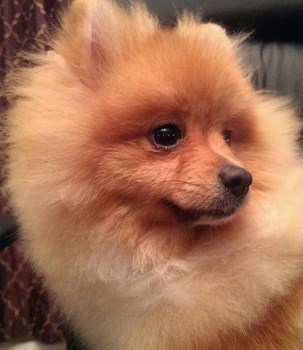

Photo courtesy of Heirloom Pomeranians
Companionship
A senior Pomeranian may sleep a bit more and may enjoy more quiet time than when younger; however being present with his owners and being close to his human family members is more important than ever.
Even when resting, an older Pom still likes to hear his owner's voice and the various noises of his humans going about their day.
Setting up a comfortable resting spots in the rooms that are the busiest can help a senior Pomeranian benefit from an orthopedic surface while remaining close by.
Owners are encouraged to find ways to include their dog in as many activities as possible while limitations in mind. For example, your senior Pom that once enjoyed those long walks may now love to ride in a canine stroller...
A Pom that always enjoyed sitting in the sun and watching his owner garden will be better on a cooling mat in the shade, etc.
Home Environment
In general, dogs like routine. Senior Pomeranian dogs do not do well with change. To the extent possible, keep your senior Pom’s home environment and routines the same. For example, his water and food bowls should be in the same location and he should be fed and walked at the usual times and in the usual places.
Keeping with set times for grooming and even
sleep time (lights are dimmed, noise is quieted down) can help make an older dog feel more secure.
Dogs with decreased vision will be more stressed if the furniture is changed around than dogs whose vision is still good. It is best to keep things where a dog is used to seeing them.
When visiting to other people's homes, bring along items that will help your Pom feel comfortable - favorite blanket, favorite toy, snacks, etc. For extended stays lasting for hours, it is a good idea to bring along your senior Pom's bed, as he may want to take a nap but may not be able to relax if feeling insecure in a different house.
Slippery floors will become a problem as your dog ages. You may notice that your Pom may begin to have trouble getting up from the bare floor, or walking across un-carpeted surfaces. It can help to cover the problem areas of the floor with a rubber-backed/non-skid runner or area rug. Other alternatives to help add traction are canine socks with non-skin bottoms or using a quality paw wax like Musher's Secret Paw Wax
 (recommended for healthy paws, at any rate).
(recommended for healthy paws, at any rate).
Also, be sure to be extra diligent in regard to trimming the hairs that may grow out from the bottom of paw pads; these hairs should be trimmed close as they can cause a dog to slip and slid.
For Poms that struggle with mobility, placing pet ramps to allow easy access to the sofa or other favorite spots can work wonderfully. The 2 areas that you may find ramps work best are up against the sofa and up to your bed (if your Pom is used to sleeping with you).
Vaccination Changes
Thinking has change recently regarding vaccinations for senior dogs. There are a growing number of veterinary professional that feel there is a decreased need to vaccinate dogs over the age of 10 years old. This is due in part to a possibly compromised immune system; other feels that the body has built up enough antibodies over the course of a decade.
This is a matter to be discussed with the veterinarian, as practices vary. Many recommend that a rabies shot is not to be given at the same time as any other immunization. In many areas, a letter stating that a dog is not healthy enough to handle a rabies shot can be shown instead of proof of immunization for legal purposes.
For dogs of any ages, immunization shots of any type should not be given if there is any illness; and therefore with a senior dog that is dealing with cancer or other disease will often not be vaccinated as to not overwhelm the body any further.
Ask you vet about a titer test that will check antibody levels in your Pom; if there are enough, he will not need a booster shot.
Winterizing Your Senior Pomeranian
When winter is upon us, we need to focus on the special needs of older Poms, who can be especially susceptible to the extremes of temperature and other stressful, dangerous conditions of winter.
(1)
Does your Pom need a sweater? What about a raincoat? Consider clothes for Pomeranians
as a means to help an older dog tolerate outside elements. In regard to rain and snow, wet fur decreases your dog's ability to fend off the cold. Even if she's never needed these before, as she gets older, she'll be less able to keep herself warm with activity.
(2)
Is your Pom’s sleeping area free from drafts? Is there a blanket and thick mattress pad for her to snuggle under/sleep on?
(3)
Ice melt chemicals can quickly burn the skin of the paw pads.
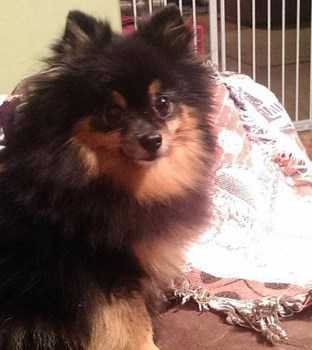

Photo courtesy of Heirloom Pomeranians
Not only are these chemicals visible when placed down, but also can be hidden in the puddles of melting ice mounds. It is recommended to keep your Pom away from any surfaces that have been sprinkled with de-icer or place seasonal boots on your Pom. If your dog is not wearing shoes or booties, take care to avoid puddles. Read more
about winter care for Pomeranians.
Vital Signs - Normal Readings for a Senior Pomeranian
What should a Pom's normal temperature, pulse, and breathing rate be? Here are the ranges:
Temperature: 99.5 - 102.8
Pulse: 60-120 beats per minute
Breathing: 14-22 breaths per minute
If you email photos to us, you agree that PetPom is given free copyright to use at our discretion. We will always credit the photo to the name of the Pom's owner(s) if it is supplied.
Email: Contact@PetPom.com
All text, images and artwork protected by US and International copyright laws. All rights reserved. Copyright PetPom.com
We are a participant in the Amazon Services LLC Associates Program, an affiliate advertising program designed to provide a means for us to earn fees by linking to Amazon.com and affiliated sites.


